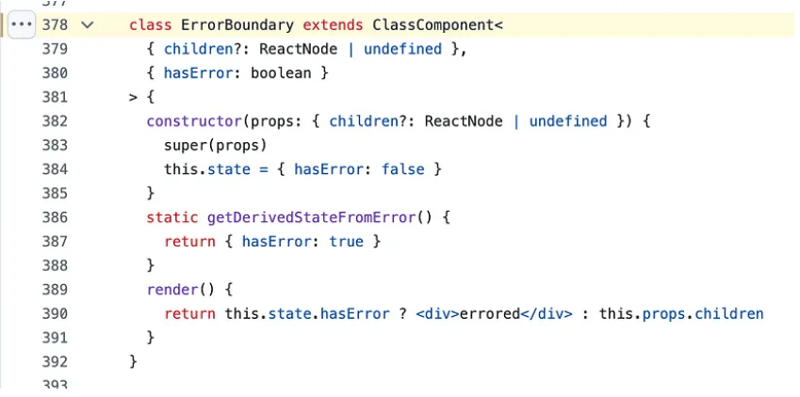In this article, we will analyze ErrorBoundary class component in Zustand’s test case. Error handling is a crucial part of any React application.

Here’s the test case we’ll be exploring:
// Picked from https://github.com/pmndrs/zustand/blob/v4.5.5/tests/basic.test.tsx#L378
it('can throw an error in equality checker', async () => {
console.error = vi.fn()
type State = { value: string | number }
const initialState: State = { value: 'foo' }
const useBoundStore = createWithEqualityFn(() => initialState, Object.is)
const { setState } = useBoundStore
const selector = (s: State) => s
const equalityFn = (a: State, b: State) =>
// @ts-expect-error This function is supposed to throw an error
a.value.trim() === b.value.trim()
class ErrorBoundary extends ClassComponent<
{ children?: ReactNode | undefined },
{ hasError: boolean }
> {
constructor(props: { children?: ReactNode | undefined }) {
super(props)
this.state = { hasError: false }
}
static getDerivedStateFromError() {
return { hasError: true }
}
render() {
return this.state.hasError ? <div>errored</div> : this.props.children
}
}
function Component() {
useBoundStore(selector, equalityFn)
return <div>no error</div>
}
const { findByText } = render(
<StrictMode>
<ErrorBoundary>
<Component />
</ErrorBoundary>
</StrictMode>,
)
await findByText('no error')
act(() => {
setState({ value: 123 })
})
await findByText('errored')
})
This test verifies that when an error occurs inside an equality checker, the error is caught and handled gracefully by an ErrorBoundary component.
Zustand allows you to define stores with custom equality functions using createWithEqualityFn. In this test, the initial state is defined as:
const initialState: State = { value: 'foo' }
The createWithEqualityFn function is used to create a store where the equality function is defined to compare states based on whether the value property is equal. In this case, the equality checker is intentionally set to throw an error when value is of a type other than string:
You can intentionally throw errors in your test cases to ensure your code handles errors as expected.
const equalityFn = (a: State, b: State) => a.value.trim() === b.value.trim() // Throws error if 'value' is not a string
The test case expects this equality function to fail when value becomes a number, causing the error handler to come into play.
React’s ErrorBoundary component is a common pattern used to catch JavaScript errors in a component tree, and Zustand has taken this approach to test how errors within their state management are handled. This particular test case defines a custom ErrorBoundary component directly inside the test. I mean, how often do you come across a test case that has the custom ErrorBoundary with in a “test case”?
class ErrorBoundary extends ClassComponent<
{ children?: ReactNode | undefined },
{ hasError: boolean }
> {
constructor(props: { children?: ReactNode | undefined }) {
super(props)
this.state = { hasError: false }
}
static getDerivedStateFromError() {
return { hasError: true }
}
render() {
return this.state.hasError ? <div>errored</div> : this.props.children
}
}
How it works:
The component uses the lifecycle method getDerivedStateFromError() to catch errors and update its state (hasError) to true.
If an error is detected, the component renders
In typical production use, ErrorBoundary components are created as reusable elements to catch and display errors across the application. However, embedding the ErrorBoundary directly inside a test case like this provides fine-grained control over error testing, allowing you to assert that the component reacts correctly when errors occur in specific parts of the application.
In this test case, Vitest is used as the testing framework. Here’s how it works with Zustand:
const { findByText } = render(
<StrictMode>
<ErrorBoundary>
<Component />
</ErrorBoundary>
</StrictMode>,
)
await findByText('no error')
At this point, the test verifies that no error has been thrown yet and checks for the text no error.
Triggering the Error: After the component is initially rendered without errors, the test triggers an error by updating the store’s state to a number:
act(() => { setState({ value: 123 }) })
This causes the equality function to throw an error, as value.trim() is no longer valid for a number type.
Asserting the Error Handling: Once the error is thrown, the ErrorBoundary catches it, and the test waits for the UI to render the errored message:
await findByText('errored')
What makes this test case particularly interesting is the use of an inline ErrorBoundary component within a unit test. Typically, error boundaries are part of the main React app, wrapping components in the main render tree. However, Zustand's approach to create an error boundary in the test suite itself offers a more flexible and isolated way to test how errors are handled under specific conditions.
By directly controlling the boundary within the test, Zustand ensures:
Granularity: The test can focus on how errors in a particular part of the application (like the equality checker) are handled, without needing to rely on global error boundaries.
Test Isolation: The ErrorBoundary exists only within the scope of this test, reducing potential side effects or dependencies on the app’s broader error-handling logic.
At Think Throo, we are on a mission to teach the advanced codebase architectural concepts used in open-source projects.
10x your coding skills by practising advanced architectural concepts in Next.js/React, learn the best practices and build production-grade projects.
We are open source — https://github.com/thinkthroo/thinkthroo (Do give us a star!)
Up skill your team with our advanced courses based on codebase architecture. Reach out to us at hello@thinkthroo.com to learn more!
以上是Here’s how Zustand’s test-case uses ErrorBoundary.的详细内容。更多信息请关注PHP中文网其他相关文章!




